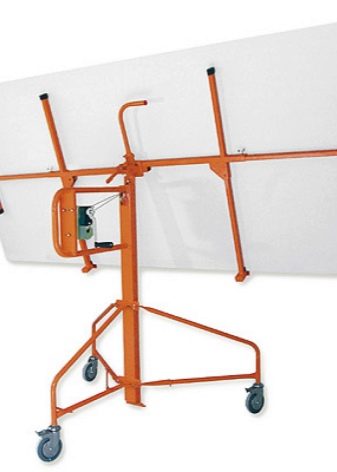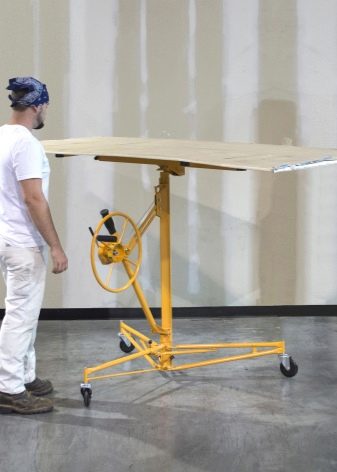Drywall lift: how to choose, do it yourself

When cladding walls, and especially ceilings, with plasterboard, it is difficult to lift and hold fragments of material at a height, since its sheets weigh from 7 to 9.5 kg. For this, a special mechanism is needed - a drywall lift. To purchase a ready-made device, you need to know how to choose it, since making it yourself is possible only with certain skills.
Drywall lifter: basic functions
The main task of the device is to facilitate the work of the master when sheathing the ceiling with large sheets of plasterboard. With the help of it, he can cope with the work process alone, without an assistant, even if it is necessary to build a multi-level plasterboard ceiling. Considering that the elevator lifts the covering sheets to a height of 4.5 meters, this is quite enough for medium and high rooms.
The structure consists of a rack placed on supports, a special bar is extended from it to the desired height. At the top is a fixed winch assembly (automatic or mechanical). In order to place gypsum plasterboards with an edge, there is a swing frame with clamps on the sliding part. The principle of operation in most cases is based on cable transmission.


However, this is not the only purpose - a homemade mechanism can help with other important work:
- by installing a laser level on it, there is the possibility of accurate, high-quality marking of the ceiling, corners;
- the lift is used to lift air conditioners, ventilation ducts, heavy chandeliers;
- the device helps with the installation of a frame made of metal profiles under the gypsum board in inaccessible places - it reliably fixes the parts while they are being fastened.
In addition, with the use of a lift, you can lift up the roll coverings and fix the perforator on it, which is extremely convenient in conditions of work at height.


Thanks to this simple device, it is possible to safely fix the material without any particular difficulties, besides, installation time is significantly saved.
Types of devices
The specific use depends on the type of structure.
There are three main types:
- Lift with a vertically installed post, designed for the assembly of wall coverings and wall cladding.
- Ceiling mechanism with vertical table for fixing drywall to the ceiling.
- Universal design "Premos". It allows you to single-handedly assemble drywall for both walls and ceilings. If necessary, you can change the angle of inclination using the turntable.


The factory movement has the following advantages:
- one person can handle simple controls;
- the structure is not exposed to dust and pollution;
- lifts gypsum boards at different angles, vertically and horizontally;
- the mechanism is prefabricated, has a low weight, in a compact form it is easy to transport.

If cladding of a small room is required, the device is folded, thereby reducing the supporting area. In this case, the supports are adjustable, so the application is relevant on an uneven floor base.


In some cases, a spacer lift is used. It is a structure consisting of two telescopic pipes, a lifting rod, as well as a clamp and stops made of rubberized polymer. The equipment is equipped with a lever to disengage the rod locking. The spacer allows the plasterboard to be held vertically.Of the advantages of the structure, one can single out low weight, a movable base, the ability to work with walls and ceilings.
The area of use of the conventional design is living rooms., production halls, balconies and corridors. It is recommended to use this model when the ceiling height is more than 3 meters.


How to choose?
When choosing the right equipment, it always makes sense to familiarize yourself with the capabilities of the equipment.
The following criteria come first:
- the weight with which the mechanism works, it can be from 30 to 50 kg;
- given the size of the ceilings, you should ask what height the drywall sheets are delivered to.
You need to know that such devices only work for lifting and cannot move loads.


The strength and solidity of the structure itself are important:
- parts of the internal mechanism and components must be made of strong and durable materials, therefore it is always better to choose models made of steel without polymer additions;
- reliable configuration of the base is a guarantee of the stability of the lift, in this respect the most worthy is the stand in the form of the letter "H".
Inexpensive models that raise drywall above 4 meters may be quite suitable for ordinary housing. If it is required to fix the coating in difficult-to-reach areas, a different direction of fastenings is provided, and a lift-strut will be the best option. It has a more complex design and can therefore be customized for a variety of tasks. True, such functional models are much more expensive than standard ones.


In addition, you need to take into account the auxiliary options, which are not always needed when installing the gypsum board. But if they are available, the price of the device rises significantly.
Since there are manual and electric models, it makes sense to choose electrical equipment for large volumes of work. It helps to increase assembly speed, but it is more expensive. According to professionals, it is better to choose manual structures for irregular construction work, especially since they do not fail so often.
Self-production
On average, standard lifting equipment costs about 15 thousand rubles, and many people prefer to assemble the device with their own hands. However, this will require detailed drawings, on the basis of which it is realistic to mount any type of lift at home. Also, in addition to metal profiles, you will have to purchase a winch and fasteners.


Professionals advise making a one-off option that can be easily adapted to other rooms later. On the other hand, you can make yourself a reusable structure that will be suitable for different heights of rooms.
A carefully drawn up scheme is the key to a high-quality assembly of the lift, because it is on it that you will have to mount the support from metal profiles and other work.

Installation process:
- The bases are made of a 6x6 cm metal profile. A couple of sections are supplied with supporting and rotating parts, the third profile is fixed to the rack using a welding machine. For ease of movement, the structure is equipped with rollers or castors.
- For greater stability, three or four pipes are welded in the form of sawed-off legs.
- A telescopic tripod or tripod is made of three cut profiles with cross-sections of 0.4, 0.6, 0.8 cm. To insert the stoppers, perforations are made into them, which must match. The bar is fixed to the rack.
- The upper part of the tripod is provided with locks for quick fastening of the stand. A metal "H" -shaped frame is welded onto the top of the tripod to further mount the retractable device.
- The table is placed on a platform, side supports are additionally mounted, increasing the rigidity of the structure. The winch, blocks and cables are attached last.


To date, German equipment is recognized as the best. Knauf, French lifts from the Edma company. This is a high-quality equipment for installation in large and small rooms with different ceiling heights.
However, the most popular device continues to be the technique "Premos" for the installation of drywall. Its device resembles the simplest rack jack, which allows you to lift a car for repairs. Due to its simplicity and reliability, as well as affordable cost, this brand remains in the first positions for a long time.


For information on how to make a drywall lift, see the next video.













The comment was sent successfully.